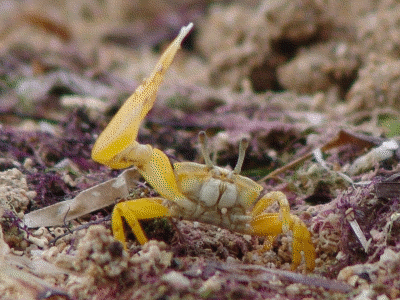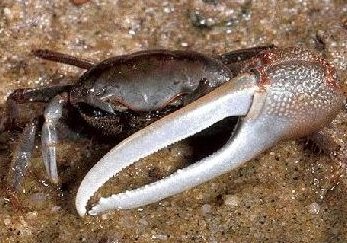|
Leptuca Spinicarpa
''Leptuca spinicarpa'', commonly known as the spiny-wristed fiddler crab or the spined fiddler crab, is a species of fiddler crab native to coastal habitats along the Gulf of Mexico from northwestern Florida to Mexico. Taxonomy Previously a member of the genus ''Uca'', the species was transferred in 2016 to the genus ''Leptuca'' when ''Leptuca'' was promoted from subgenus to genus level. At one time, ''L. spinicarpa'' was reduced to a subspecies of '' L. speciosa'', but this is no longer accepted due to morphological, genetic, and behavioral differences. Description The carapace can be up to 23mm wide and is often green in color in the frontal area. Strongly raised tuberculate ridges are present on the palm of the male's major cheliped; a large tubercle is present on the carpus In human anatomy, the wrist is variously defined as (1) the carpus or carpal bones, the complex of eight bones forming the proximal skeletal segment of the hand; "The wrist contains eight bones, ro ... [...More Info...] [...Related Items...] OR: [Wikipedia] [Google] [Baidu] |
Mary J
Mary may refer to: People * Mary (name), a feminine given name (includes a list of people with the name) Religious contexts * New Testament people named Mary, overview article linking to many of those below * Mary, mother of Jesus, also called the Blessed Virgin Mary * Mary Magdalene, devoted follower of Jesus * Mary of Bethany, follower of Jesus, considered by Western medieval tradition to be the same person as Mary Magdalene * Mary, mother of James * Mary of Clopas, follower of Jesus * Mary, mother of John Mark * Mary of Egypt, patron saint of penitents * Mary of Rome, a New Testament woman * Mary, mother of Zechariah and sister of Moses and Aaron; mostly known by the Hebrew name: Miriam * Mary the Jewess one of the reputed founders of alchemy, referred to by Zosimus. * Mary 2.0, Roman Catholic women's movement * Maryam (surah) "Mary", 19th surah (chapter) of the Qur'an Royalty * Mary, Countess of Blois (1200–1241), daughter of Walter of Avesnes and Margaret of Blois * ... [...More Info...] [...Related Items...] OR: [Wikipedia] [Google] [Baidu] |
Fiddler Crab
The fiddler crab or calling crab may be any of more than one hundred species of semiterrestrial marine crabs in the family Ocypodidae, well known for their sexual dimorphism, sexually dimorphic claws; the males' major claw is much larger than the minor claw, while the females' claws are both the same size. A smaller number of ghost crab and mangrove crab species are also found in the family Ocypodidae. This entire group is composed of small crabs, the largest being slightly over two inches (5 cm) across. Fiddler crabs are found along sea beaches and brackish intertidal mud flats, lagoons, swamps, and various other types of brackish or salt-water wetlands. Like all crabs, fiddler crabs molting, shed their shells as they grow. If they have lost legs or claws during their present growth cycle, a new one will be present when they molt. If the large fiddle claw is lost, males will develop one on the same side after their next molt. Newly molted crabs are very vulnerable because o ... [...More Info...] [...Related Items...] OR: [Wikipedia] [Google] [Baidu] |
Gulf Of Mexico
The Gulf of Mexico ( es, Golfo de México) is an oceanic basin, ocean basin and a marginal sea of the Atlantic Ocean, largely surrounded by the North American continent. It is bounded on the northeast, north and northwest by the Gulf Coast of the United States; on the southwest and south by the Mexico, Mexican States of Mexico, states of Tamaulipas, Veracruz, Tabasco, Campeche, Yucatan, and Quintana Roo; and on the southeast by Cuba. The Southern United States, Southern U.S. states of Texas, Louisiana, Mississippi, Alabama, and Florida, which border the Gulf on the north, are often referred to as the "Third Coast" of the United States (in addition to its Atlantic and Pacific Ocean, Pacific coasts). The Gulf of Mexico took shape approximately 300 million years ago as a result of plate tectonics.Huerta, A.D., and D.L. Harry (2012) ''Wilson cycles, tectonic inheritance, and rifting of the North American Gulf of Mexico continental margin.'' Geosphere. 8(1):GES00725.1, first p ... [...More Info...] [...Related Items...] OR: [Wikipedia] [Google] [Baidu] |
Florida
Florida is a state located in the Southeastern region of the United States. Florida is bordered to the west by the Gulf of Mexico, to the northwest by Alabama, to the north by Georgia, to the east by the Bahamas and Atlantic Ocean, and to the south by the Straits of Florida and Cuba; it is the only state that borders both the Gulf of Mexico and the Atlantic Ocean. Spanning , Florida ranks 22nd in area among the 50 states, and with a population of over 21 million, it is the third-most populous. The state capital is Tallahassee, and the most populous city is Jacksonville. The Miami metropolitan area, with a population of almost 6.2 million, is the most populous urban area in Florida and the ninth-most populous in the United States; other urban conurbations with over one million people are Tampa Bay, Orlando, and Jacksonville. Various Native American groups have inhabited Florida for at least 14,000 years. In 1513, Spanish explorer Juan Ponce de León became the first k ... [...More Info...] [...Related Items...] OR: [Wikipedia] [Google] [Baidu] |
Mexico
Mexico (Spanish: México), officially the United Mexican States, is a country in the southern portion of North America. It is bordered to the north by the United States; to the south and west by the Pacific Ocean; to the southeast by Guatemala, Belize, and the Caribbean Sea; and to the east by the Gulf of Mexico. Mexico covers ,Mexico ''''. . making it the world's 13th-largest country by are ... [...More Info...] [...Related Items...] OR: [Wikipedia] [Google] [Baidu] |
Leptuca
''Leptuca'' is a genus of fiddler crabs belonging to the family Ocypodidae. The species of this genus are found on the coasts of the Americas. Description They are small- to large-sized crabs with an adult carapace width of 5–25 mm in adults. The front of their carapace is broad and they have short anterolateral margins with 0–2 posterolateral striae on the top of the carapace. Species There are currently 30 species in the genus: * '' Leptuca batuenta'' (Crane, 1941) (beating fiddler crab) * '' Leptuca beebei'' (Crane, 1941) (Beebe's fiddler crab) * ''Leptuca coloradensis'' (Rathbun, 1893) (painted fiddler crab) * '' Leptuca crenulata'' (Lockington, 1877) (Mexican fiddler crab) * '' Leptuca cumulanta'' (Crane, 1943) (heaping fiddler crab) * '' Leptuca deichmanni'' (Rathbun, 1935) (Deichmann's fiddler crab) * ''Leptuca dorotheae'' (von Hagen, 1968) (Dorothy's fiddler crab) * ''Leptuca festae'' (Nobili, 1902) (Festa's fiddler crab) * '' Leptuca helleri'' (Rathbun, 1902) ( ... [...More Info...] [...Related Items...] OR: [Wikipedia] [Google] [Baidu] |
Leptuca Speciosa
''Leptuca speciosa'', commonly known as the brilliant fiddler crab or the longfinger fiddler crab, is a species of fiddler crab native to the southern United States, Mexico, and the Caribbean. Before 2016, the species was known as ''Uca speciosa''. In 2016, the subgenus ''Leptuca ''Leptuca'' is a genus of fiddler crabs belonging to the family Ocypodidae. The species of this genus are found on the coasts of the Americas. Description They are small- to large-sized crabs with an adult carapace width of 5–25 mm in adult ...'' was promoted to the genus level. Description The carapace can be up to 15mm wide. The large claw of the male is long and whitish, with the carpus lacking a distinct tubercle on the inner margin. Specimens from the Florida Keys are typically smaller than specimens from the northern Gulf. Distribution In the United States, the crabs are present along the coast of Florida and on the outer islands of Alabama and Mississippi. The crabs are also present on ... [...More Info...] [...Related Items...] OR: [Wikipedia] [Google] [Baidu] |
Carapace
A carapace is a Dorsum (biology), dorsal (upper) section of the exoskeleton or shell in a number of animal groups, including arthropods, such as crustaceans and arachnids, as well as vertebrates, such as turtles and tortoises. In turtles and tortoises, the underside is called the plastron. Crustaceans In crustaceans, the carapace functions as a protective cover over the cephalothorax (i.e., the fused head and thorax, as distinct from the abdomen behind). Where it projects forward beyond the eyes, this projection is called a rostrum (anatomy), rostrum. The carapace is Calcification, calcified to varying degrees in different crustaceans. Zooplankton within the phylum Crustacea also have a carapace. These include Cladocera, ostracods, and Isopoda, isopods, but isopods only have a developed "cephalic shield" carapace covering the head. Arachnids In arachnids, the carapace is formed by the fusion of prosomal tergites into a single Plate (animal anatomy), plate which carries the e ... [...More Info...] [...Related Items...] OR: [Wikipedia] [Google] [Baidu] |
Cheliped
A chela ()also called a claw, nipper, or pinceris a pincer-like organ at the end of certain limbs of some arthropods. The name comes from Ancient Greek , through New Latin '. The plural form is chelae. Legs bearing a chela are called chelipeds. Another name is ''claw'' because most chelae are curved and have a sharp point like a claw. Chelae can be present at the tips of arthropod legs as well as their pedipalps. Chelae are distinct from spider chelicerae in that they do not contain venomous glands and cannot distribute venom. See also * Pincer (biology) * Pincer (tool) Pincers are a hand tool used in many situations where a mechanical advantage is required to pinch, cut or pull an object. Pincers are first-class levers, but differ from pliers in that the concentration of force is either to a point, or to an ... References Arthropod anatomy {{Arthropod-anatomy-stub ... [...More Info...] [...Related Items...] OR: [Wikipedia] [Google] [Baidu] |
Carpus
In human anatomy, the wrist is variously defined as (1) the carpus or carpal bones, the complex of eight bones forming the proximal skeletal segment of the hand; "The wrist contains eight bones, roughly aligned in two rows, known as the carpal bones." (2) the wrist joint or radiocarpal joint, the joint between the radius and the carpus and; (3) the anatomical region surrounding the carpus including the distal parts of the bones of the forearm and the proximal parts of the metacarpus or five metacarpal bones and the series of joints between these bones, thus referred to as ''wrist joints''. "With the large number of bones composing the wrist (ulna, radius, eight carpas, and five metacarpals), it makes sense that there are many, many joints that make up the structure known as the wrist." This region also includes the carpal tunnel, the anatomical snuff box, bracelet lines, the flexor retinaculum, and the extensor retinaculum. As a consequence of these various definitions, fract ... [...More Info...] [...Related Items...] OR: [Wikipedia] [Google] [Baidu] |
Ocypodoidea
The Ocypodoidea, or ocypoid crabs, are a superfamily of crabs, named after the genus ''Ocypode''. It contains over 300 extant species in these eight families: * Camptandriidae Stimpson, 1858 * Dotillidae Stimpson, 1858 * Heloeciidae H. Milne-Edwards, 1852 * Macrophthalmidae Dana, 1851 * Mictyridae Dana, 1851 * Ocypodidae The Ocypodidae are a family of semiterrestrial crabs that includes the ghost crabs and fiddler crabs. They are found on tropical and temperate shorelines around the world. Some genera previously included in the family are now treated as members o ... Rafinesque, 1815 * Ucididae Števčić, 2005 * Xenophthalmidae Stimpson, 1858 References Crabs Taxa named by Constantine Samuel Rafinesque Arthropod superfamilies {{crab-stub ... [...More Info...] [...Related Items...] OR: [Wikipedia] [Google] [Baidu] |




